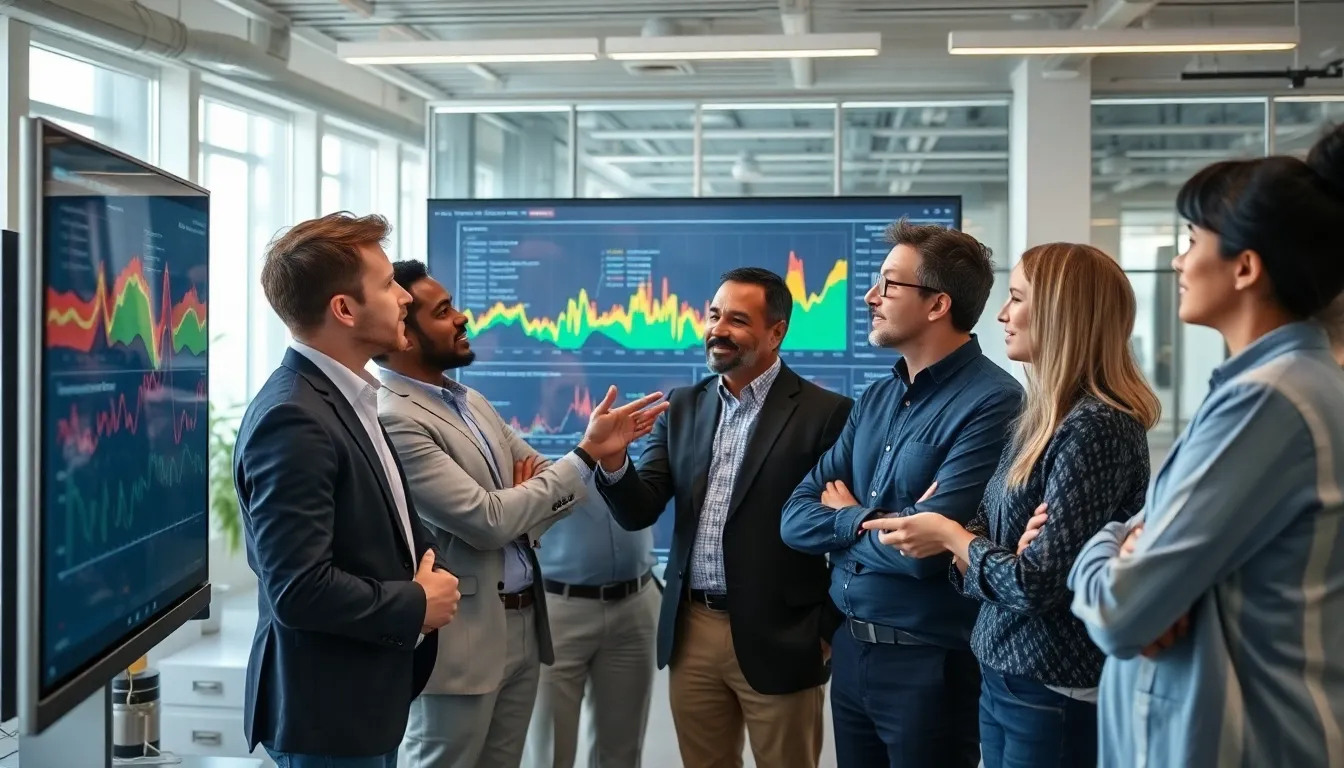In a world overflowing with data, making sense of it can feel like trying to find a needle in a haystack—while blindfolded. Enter predictive visualization, the superhero of analytics that swoops in to save the day. It transforms complex data sets into vivid, easy-to-understand visuals, allowing businesses to see the future without needing a crystal ball.
Table of Contents
ToggleOverview of Predictive Visualization
Predictive visualization leverages advanced analytics to transform complex data into easily digestible visuals. By utilizing algorithms, it anticipates trends and patterns, guiding businesses in strategic decision-making. High-quality visuals convey critical insights, allowing stakeholders to interpret data rapidly.
Numerous industries benefit from predictive visualization. Retailers analyze purchasing behaviors to forecast inventory demands. Healthcare providers leverage data visuals to predict patient outcomes and optimize treatment plans. Financial institutions use predictive analytics to assess risks and identify investment opportunities.
Key components include data integration, statistical modeling, and user-friendly interfaces. Integrating diverse data sources enables comprehensive analysis. Statistical models analyze historical data for accurate predictions. Intuitive interfaces enhance user engagement, allowing non-technical users to interact with complex data seamlessly.
Within predictive visualization, various techniques enhance clarity and effectiveness. Heatmaps highlight areas of high activity, while line graphs visualize trends over time. Dashboards consolidate relevant metrics, offering real-time insights at a glance. With effective communication of findings, stakeholders can make informed choices.
Organizations adopting predictive visualization demonstrate heightened agility. Data-driven strategies stem from the ability to visualize potential outcomes. As businesses prioritize insights derived from predictive analytics, they position themselves for sustained growth in competitive markets.
Benefits of Predictive Visualization

Predictive visualization offers multiple benefits that enhance business operations. Companies leverage this tool to streamline decision-making and gain valuable insights from complex data sets.
Enhanced Decision-Making
Enhanced decision-making occurs when businesses use predictive visualization tools. Visual representations of data allow stakeholders to grasp trends quickly. Decision-makers access key metrics in real-time, which facilitate faster responses to market changes. Forecasts generated from data analysis highlight potential outcomes, improving planning accuracy. Users capitalizing on predictive insights are more likely to make informed choices that drive growth. Enhanced collaboration emerges, as teams visualizing data align their strategies based on clear and comprehensible information.
Improved Data Insights
Improved data insights stem from the clarity that predictive visualization provides. By transforming raw data into meaningful visuals, organizations unlock hidden patterns. Identifying trends becomes easier, which allows for proactive approaches to problem-solving. For instance, retail companies can pinpoint inventory needs more accurately by analyzing visualized sales data. This method empowers stakeholders to focus on significant factors influencing their performance. Understanding relationships between variables leads to deeper analyses, strengthening overall business intelligence efforts. Collectively, improved insights from predictive visualization create opportunities for strategic advancements.
Techniques in Predictive Visualization
Predictive visualization employs various techniques to analyze data effectively. These methods facilitate clear interpretation and proactive decision-making for businesses across sectors.
Data Mining and Analysis
Data mining serves as a foundational technique in predictive visualization. Analysts extract valuable insights from large datasets, identifying patterns and trends that inform strategic initiatives. Techniques like clustering and classification enhance the ability to segment data accurately, allowing organizations to target specific customer groups. Analysts use statistical tools to evaluate correlations within the data, revealing hidden relationships. Predictive analytics models rely heavily on these analyses to forecast future occurrences effectively. By employing advanced algorithms, organizations can address complex queries rapidly, leading to better business outcomes.
Machine Learning Integration
Machine learning integrates seamlessly into predictive visualization, enhancing data interpretation capabilities. Algorithms can analyze historical data, making predictions based on trends and behaviors. Systems improve accuracy over time as they process more data, adapting to new information and refining forecasts. Real-time data processing enables insights to be updated continuously, ensuring decision-makers have access to the latest trends. Visualization tools harness machine learning outputs to create dynamic representations, allowing stakeholders to engage with predictions intuitively. Organizations that implement machine learning-powered predictive visualization benefit from increased responsiveness and more informed strategies.
Applications of Predictive Visualization
Predictive visualization finds applications across various fields, driving advancements and enhancing performance. Two prominent areas include business intelligence and healthcare analytics.
Business Intelligence
Business intelligence utilizes predictive visualization to transform raw data into actionable insights. Organizations can identify trends and patterns using tools like dashboards and heatmaps. Data integration allows for a comprehensive overview, facilitating better decision-making. By anticipating market changes, businesses become more agile in their strategies. Visual representations enhance clarity, enabling stakeholders to access key metrics quickly and effectively. Ultimately, this leads to improved operational efficiency and a competitive edge.
Healthcare Analytics
Healthcare analytics employs predictive visualization to forecast patient outcomes and optimize resource allocation. Utilizing data from electronic health records enables healthcare professionals to identify potential health risks early. Visual tools help in monitoring patient trends, ensuring timely interventions. Decision-makers can explore various scenarios through simulations, enhancing treatment plans. By prioritizing data visualization, healthcare providers improve patient care and streamline operations. These applications drive better health outcomes while focusing on strategic planning.
Challenges in Predictive Visualization
Predictive visualization presents distinct challenges that organizations must address to harness its full potential. Key difficulties include data quality issues and interpretation of results, both of which can hinder effective decision-making.
Data Quality Issues
Data quality issues significantly impact predictive visualization. Inaccurate, incomplete, or outdated data skew analyses, leading to misleading predictions. Organizations must implement robust data governance practices to ensure high-quality datasets. Regular data cleaning, validation, and integration from diverse sources can enhance accuracy. Attention to detail in dataset management increases the reliability of insights drawn from predictive visualizations. When data quality remains a priority, organizations can trust their visual outputs for strategic planning.
Interpretation of Results
Interpreting results from predictive visualization poses another challenge. Stakeholders may struggle to understand complex visual representations without deep analytical expertise. Misinterpretations can lead to poor decision-making or skipped opportunities. Providing clear context alongside visual data aids in fostering understanding. Training sessions geared toward enhancing data literacy can empower users to grasp insights without technical confusion. By clarifying visual information, organizations can align their strategies with informed predictions, boosting overall efficacy in decision-making.
Predictive visualization stands as a transformative approach for organizations navigating complex data landscapes. By turning intricate datasets into clear and actionable visuals, it empowers businesses to make informed decisions swiftly. The integration of advanced analytics and user-friendly interfaces ensures that even non-technical users can access vital insights.
As industries continue to embrace this technology, the ability to anticipate trends and respond proactively will be crucial for maintaining a competitive edge. Addressing challenges like data quality and interpretation will further enhance the effectiveness of predictive visualization. Ultimately, organizations that harness its power will drive growth and innovation in an ever-evolving marketplace.






